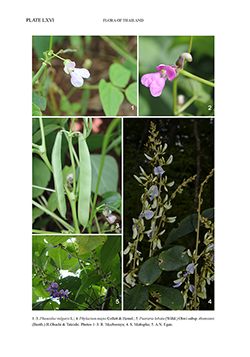e-Flora of Thailand
Volume 4 > Part 3.3 > Year 2023 > Page 642 > Leguminosae-Papilionoideae > Phaseolus
2. Phaseolus vulgaris L.wfo-0000183282
Sp. Pl. 2: 723. 1753; DC., Prodr. 2: 392. 1825; Roxb., Fl. Ind., ed. 3: 287. 1832; Baker in Hook.f., Fl. Brit. India 2(4): 200. 1876; Merr., Fl. Manila: 261. 1912; Gagnep. in Lecomte, Fl. Indo-Chine 2(3): 225. 1916; Merr., Enum. Philipp. Fl. Pl. 2: 319. 1923; Backer & Bakh.f., Fl. Java 1: 639. 1963; Thuân in Aubrév. & J.-F.Leroy, Fl. Cambodge, Laos & Vietnam 17: 172, pl. 27, f. 1–12. 1979; Grierson & D.G.Long, Fl. Bhutan 1(3): 702, f. 41, n–r. 1987; R.H.Maxwell in Dassanayake & Fosberg, Revis. Handb. Fl. Ceylon 7: 345. 1991; T.L.Wu & Thulin in C.Y.Wu et al., Fl. China 10: 260. 2010. Plate LXVI: 1–3.
Accepted Name : This is currently accepted.
Description : Annual herb; stems twining, prostrate, 0.2–1.5 m long, or erect, 30–50 cm tall, glabrescent to sparsely pubescent, usually with uncinated hairs. Stipules ovate, ovate-lanceolate or lanceolate, 2.5–5 by 0.5–3 mm, apex acute or obtuse, base truncate, margin entire, outside glabrescent to sparsely pubescent, inside glabrous. Leaves: petioles 4–13 cm long, glabrescent to sparsely pubescent, usually with uncinated hairs; rachis 1.5–4.5 cm long, sparsely pubescent, usually with uncinated hairs. Leaflets pubescent on both surfaces and along margin; lateral veins 3–5 pairs; terminal leaflet rhomboid or ovate, 5–11 cm by 3.5–10 cm, apex acute or attenuate, base cordate, truncate or rounded, margin entire; lateral leaflets obliquely ovate, 5.5–11 cm by 4–9 cm, apex acute or attenuate, base truncate, rounded or subcordate, margin entire; petiolules 2.5–6 mm long, densely pubescent; stipels lanceolate or elliptic, 2.5–3 by ca 0.5 mm, apex acute or obtuse, base truncate, margin entire, pubescent at base. Inflorescences 1–3-fascicled, nodose-pseudoracemes, rarely nodose-pseudopanicles; peduncle (0.2–)1.5–5 cm long, glabrescent to densely pubescent, usually with uncinated hairs; axis (0.1–)0.8–3 cm, glabrescent to densely pubescent, usually with uncinated hairs; fascicled bract 1, persistent, broadly ovate, 3–5 by 2.5–3 mm, striate, apex acute, base truncate, outside and along margin sparsely pubescent, inside glabrous. Flowers 2 in each fascicle, purple, pink or white; pedicels purple or green, 0.5–1.2 cm long, glabrescent to densely pubescent; bracteole attached to base of pedicel 1, ovate or elliptic, ca 2.5 by 1 mm, striate, apex acute, base truncate, caducous; bracteoles appressed to base of calyx tube 2, broadly elliptic, 5–8 by 3.5–4 mm, striate, apex acute or obtuse, base truncate or obtuse, persistent. Calyx: tube 3–4 by ca 5 mm; two upper lobes connate, apex slightly divided to shallow lobes; three lower lobes deltoid, the lowest lobe ca 1.5 mm long and lateral lobes ca 1 mm long, outside and along margin sparsely to densely pubescent, inside glabrous. Corolla: standard purple, pink or white, suborbicular, 0.8–1.4 by 0.9–1.2 cm, apex retuse, base with 2 small auricles, claw 2–3 mm long; wings purple, pink or white, obovate, 1.2–1.8 by 0.5–0.7 cm, apex rounded, base with 2 opposite appendages, 0.5–1 mm long, claw ca 5 mm long; keel light green or greenish white, oblong, 1.5–2.5 by 0.2–0.3 cm, apex incurved, coiled, claw 3–4 mm long. Stamens: filaments white or pale green, 1.5–2 cm long; anthers yellow, oblong, ca 0.5 mm long. Pistil 1.5–2.3 cm long; ovary green, linear, sparsely to densely pubescent, base shortly stipitate; style white, filiform, dilated and beard near apex. Pods linear and slightly compressed or terete, sometimes slightly constricted between seeds, 8–18 by 0.5–1 cm, apical beak 0.5–1.2 cm long, glabrous or glabrescent; base stipitate, ca 1.5 mm long; fruit stalk 0.8–1.2 cm long, glabrous or grabrescent. Seeds 5–10, various colour, brown, reddish brown, yellowish brown, black or white, sometimes with mottling, kidney-shaped, ellipsoid or ovoid, 0.8–1.8 by 0.3–1 cm
Thailand : Cultivated in northern Thailand.
Distribution : Native of tropical America; widely cultivated throughout the world (cultivated in Uppsala – type).
Vernacular : Thua daeng luang (ถั่วแดงหลวง), thua dam (ถั่วดำ), thua khaek (ถั่วแขก), thua khao (ถั่วขาว), thua khem (ถั่วเข็ม)(Bangkok); thua bung (ถั่วบุ้ง)(Central); thua farang (ถั่วฝรั่ง)(Northern).
CommonName : Common bean, Kidney bean, Pinto bean, Snap bean, String bean.
Uses: Young pods and seeds are eaten as vegetables; dried seeds are eaten as dessert.

